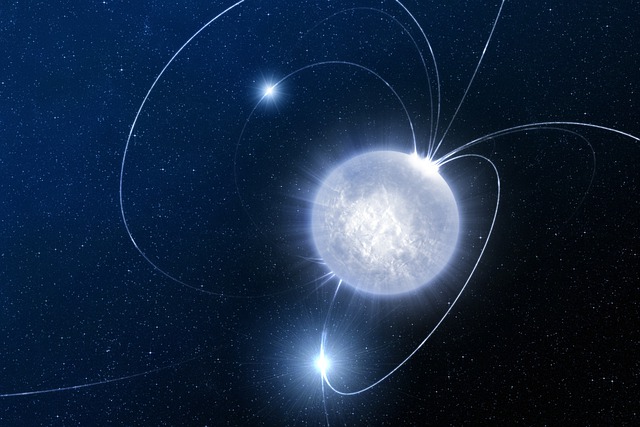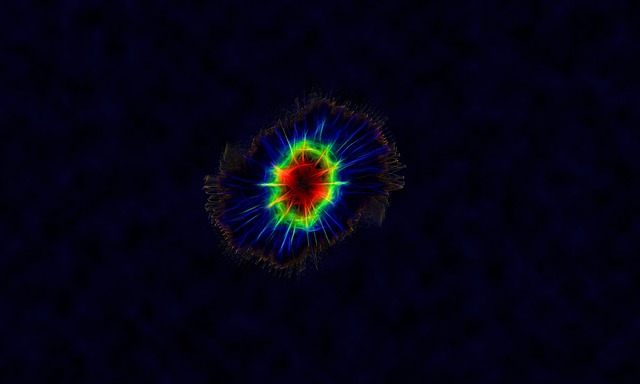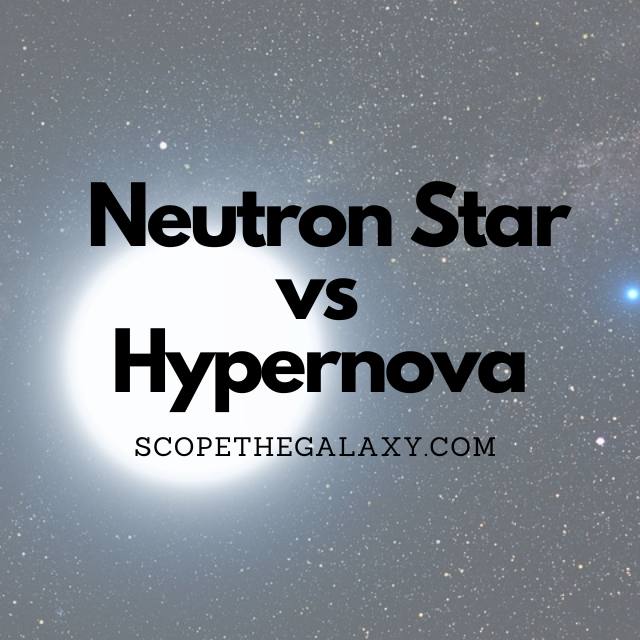*This post may contain affiliate links. This means we may make a commission if you purchase an item using one of our links*
The main difference between a neutrom star and hypernova is that a neutron star is the extremely dense remnant of a dead star that is 10 -20 solar masses or a white dwarf that has gone supernova, whilst a hypernova occurs when a star that is 30+ solar masses explodes and creates the most powerful and luminous explosion in the known universe, leaving behind black holes in the end.
There are other differences between the two so continue reading if you a want a more thorough breakdown of both cosmic entities below.
What Is A Neutron Star?
Table of Contents

When a star 10 to 20 times more massive than our sun or more massive than the Chandrasekhar limit of 1.44 solar masses, reaches the end of its life, the core collapses, and the outer matter explodes in a supernova. What remains is known as a neutron star.
Neutron stars can come in two main varieties, acting either as an active pulsating pulsars or the more erratic and powerful magnetars.
The neutron star gets its name from the fact that after the initial explosion of the star, gravity presses the remaining material so tightly that it forces protons and electrons to combine and form neutrons.
If the star’s mass is greater than 20 times our sun’s, this reaction is likely to create a black hole. While black holes are almost impossible to observe, neutron stars are straightforward, thanks to pulsating light.
A neutron takes a mass greater than twice the sun’s mass and condenses it into a spherical object no bigger than one of Earth’s cities. These mysterious objects are still not entirely understood by scientists.
The atmosphere of a neutron star comprises hydrogen, helium, and carbon. The outer crust contains ions and electrons, while the inner crust contains ions and superfluid neutrons. The outer core is superconducting protons, but what exactly comprises the inner core? That fact remains unknown.
The gravity of these objects is so strong that it bends its light waves around its body, making it easier for scientists to determine the size and mass of these stars.
What Is A Hypernova?

Hypernovae are supernova explosions but on steroids.
In essence your typical hypernova will produce explosions that are anywhere from 5 times to 50 times more powerful than a supernova explosion.
The typical hypernova will be formed after the death of star that is atleast 30 times the mass of our Sun, where they will generally have enough mass after the explosion to form a spinning black hole surrounded by an accretion disc and two stellar jets traveling close to it at the speed of light.
These explosion are much rarer than your typical supernova as they tend only to be observed 5 times over a million year period but, when they do happen, they’ll often produce light that is 10 – 100 times the brightness of a supernova.
Considering supernovae produce light that is often brighter than entire galaxies, a hypernova explosion would be blinding.
Not to mention extremely powerful where in the theory one explosion, that would typically have remnants sticking around a few months, would be able to power Earth for a billion, billion, billion years!
After the explosion has settled, only a black hole will remain. This is quite a juxtaposition as arguably the most luminous showcase produced in the universe tends to create celestial objects that allows no light to escape it.
Similarities Between Neutron Stars And Hypernovae
Although the two don’t share too much in common, they are still somewhat related.
This is because neutron stars form after a larger solar mass star explodes in a supernova explosion, which is simply a weaker less luminous hypernova explosion.
Hypernova explosions as a result also leave behind a dead start remnant but, instead of a neutron star, a black hole is what remains
Differences Between Neutron Stars And Hypernovae
In regards to these differences,.they would include the following:
- A hypernova explosion is amongst the brightest entities in our known universe, often eclipsing galaxies in brightness whilst a neutron star isn’t nearly as bright, which mostly would be down to its size.
- A neutron Star is typically around 15 – 25km in diameter whilst hypernovae are far larger often growing at 15,000 – 40,000km every second much like supernovae.
- A neutron star is the dead remnant of star that has gone through a supernova explosion whilst a hypernova occurs when a 30+ solar mass star is unable to continue in the process of nuclear fusion, exploding and leaving behind a black hole.
- A neutron star is able to warp space and time around it whilst a hypernova cannot as it is not as dense.
- Neutron stars tend to be around 1 million+ degrees Celsius whilst hypernova can exceed 1 billion degrees in temperature.
- Neutron stars have a mass of 1.4 solar masses on average although at the upper end they can achieve a solar mass of 3.2.
- A hypernova occurs once every 200,000 years whilst a neutron star forms once every 50 years, which is typically how long supernova occur.
- Neutron stars have a near infinite lifespan in comparison to a hypernova which typically lasts between 2 seconds and 2 minutes and will light up outer space for a few months at most, much like the smaller supernova explosion.
Summary
Ultimately, a hypernova explosion and neutron stars are linked in the sense that a grandiose explosion from a larger star or a white dwarf is necessary to create them however, the difference is simply based on the mass of the star that explodes.
As a result a hypernova cannot create a neutron star as its mass exceeds the range to create one and would instead form the denser and darker black hole.

